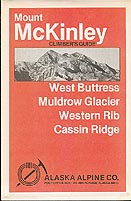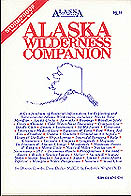
|
Climbing Alaska's Mt. McKinley has been described alternately as a long walk in the snow, or as one of the most difficult high mountain ascents in the world, depending 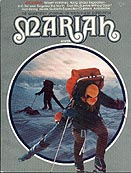 The Expedition
The ExpeditionThat Fell From The Sky on the route being climbed and conditions encountered along the way. Even in mid summer, conditions on North America's tallest mountain are arctic in character. During the two- to four-week ascent, most parties encounter temperatures ranging from + 70° to - 40° F. (+ 27° to - 40° C.). Winds in excess of 100 m.p.h. (160 k.p.h.) are not uncommon.  Individual storms sometimes last two weeks, making it imperative that climbers prepare for at least a month's climb on easier routes and as much as six weeks on difficult routes. Although nearly 3,000 climbers have stood on its 20,320-foot (6,194-meter) summit since the first ascent in 1913, none have treated the mountain casually. Over forty have died on its slopes. As on big mountains elsewhere, hidden crevasses have taken unnecessary lives. Climbers should always travel roped, no matter how easy the terrain appears. Expeditions planning to attempt Mt. McKinley must register at least two months in advance with the National Park Service and should complete all preparations before coming to Alaska, including arrangements for a radio and charter air transportation. Climbers should also plan on removing all their equipment and trash from the mountain.  West Buttress Westliche Stützmauer Le Contrefort de l'Ouest South Buttress Südliche Stützmauer Le Contrefort du Sud Muldrow Glacier Muldrow Gletscher Le Glacier Muldrow West Rib Westliche Rippe La Côte de l'Ouest Cassin Ridge Cassin Kamm La Crête Cassin Coming Soon Doug Scott & Dougal Haston's South Face Direct This map and the climbing descriptions can only serve as general guides to the five major routes on Mt. McKinley because of daily and seasonal conditions. On a big mountain, no guide or map can safely be substituted for good mountaineering judgement. Copyright © 2001 by Dennis Cowals. All rights reserved. Ice axe and rope logo copyright © 2001 by Dennis Cowals. Mountaineers edition copyright © 1981 by Dennis Cowals ISBN 0-89886-020-2. Original edition copyright © 1976 by The Alaska Alpine Company. |
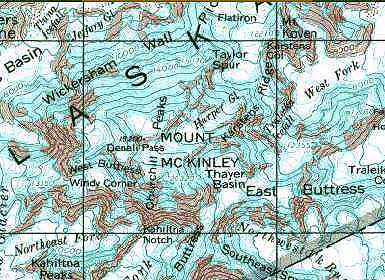
Mt. McKinley 1:250,000 scale - U.S. Geological Survey
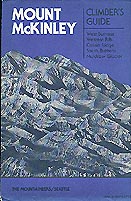
Denali National
Park & Preserve
Mountaineering
Guidelines,
Regulations
& Information
Mountaineering in
Denali National Park
& Preserve
National Weather Service
Alaska Region
Denali National Park
Weather Forecast
Wind Chill Calculator
North to Alaska?
These friends
are good folks
to contact.
We've shared
many climbs,
rescues and
adventures
over the years.
Cassin Kamm - La Crête Cassin
FIRST ASCENT: June 24 to July 19, 1961 by Riccardo Cassin, Luigi Airoldi, Luigi Alippi, Giancarlo Canali, Romano Perego and Annibale Zucchi. Despite the handicap of beginning the route from the Northeast Fork of the Kahiltna Glacier instead of the East Fork as had been planned, Cassin's strong team pushed up the heavily crevassed glacier and established a base camp at 11,320 feet. Beginning the climb on July 5, the party slowly moved upward on the most difficult rock and ice pitches McKinley has to offer. Despite frequent storms, high winds, spindrift avalanches and mists which glazed the rock with sheets of ice, Cassin and his climbers emerged on the summit ridge exhausted, and reached the South Summit in a final 17-hour push from their high camp. (Subsequent Japanese [Hokkaido Alpine Association - May 26, 1967], American [Everett - August 2, 1967] and French [Berquet - July 23, 1971] ascents have refined the route up the South Face by discovering safer, faster and sometimes easier alternatives to some of Cassin's pitches. Still, the Cassin Ridge is the mountain's most difficult route and should be attempted only by strong parties. The route described below, then, is a composite made possible by exceptional climbers from four nations.)
POINT OF DEPARTURE: Southeast Fork, Kahiltna Glacier
ALTITUDE GAIN: 13,320 feet (4,060 meters)
ROUND TRIP DISTANCE: 24 miles (38 kilometers), not
including relays which can double the overland distance TIME: 21 to 35 days
CRUX: The Japanese Couloir between 12,400 and 13,400
feet (3,780 and 4,084 meters)
SPECIAL EQUIPMENT: 5,000 to 8,000 feet (1,600 to 2,400
meters) of fixed rope and 20 snow pickets; 24 ice
pitons; 60 rock pitions (mostly horizontals and small to
medium angles including a few knifeblades)
ROUTE: From the landing area on the Southeast Fork of the Kahiltna Glacier, move west to join the main glacier. Turn right, north, and proceed approximately 2.4 miles (3.8 kilometers) to the junction with the East Fork. Take an easterly course up the left center of the glacier that swings more and more to the north as the glacier curves around to meet the South Face.
At 11,200 feet (3,134 meters) enter a prominent - but narrow - ice couloir and climb it to gain Kahiltna Notch at 11,960 feet (3,645 meters).
Rappel down 300 feet (100 meters) to gain the upper snowfield of the Northeast Fork of the Kahiltna Glacier and traverse north to the base of the Japanese Couloir at 12,400 feet (3,780 meters). Although conditions make individual pitches higher on the mountain more difficult, most climbers agree the Japanese Couloir is the crux of the Cassin Ridge Route with three pitches each of ice, snow and rock, snow and ice and two pure rock pitches. From the top of the couloir at 13,400 feet (4,084 meters) move up and to the right over mixed ground, climbing a rock couloir to gain a narrow snow ridge. Follow the ridge to the prominent hanging glacier.
Continue moving up the glacier to reach mixed dpitches of ice and rock. These lead upward for 1,000 feet (300 meters) to Cassin's Rib Pitch, a difficult 150-foot (50-meter) rock wall. Once over the barrier, follow the ridge to easier ground.
Bearing left, climb pitches of snow and rock to another vertical granite wall which may be climbed via a 300-foot (100-meter) rock couloir. From the top of the couloir, traverse right, east, approximately 1,000 feet (300 meters) to a prominent snowfield and climb it. Doing so avoids difficult rock pitches climbed by Cassin's party. Continue up the snowfield until regaining the ridge above the 17,000-foor (5,182-meter) level.
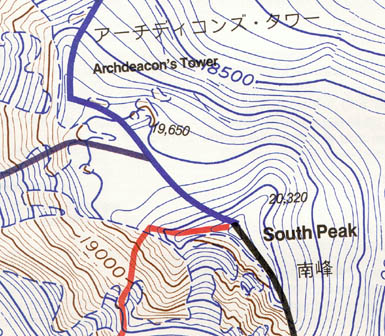
Mt. McKinley Summit 1:25,000 scale - adapted from U.S.G.S.
West Buttress West Rib Cassin Ridge South Buttress
Mixed ground leads to the base of the last buttress at 18,500 feet (5,639 meters). Move up and left through a succession of coulois and pitches of rock and snow to gain the summit ridge. Depending on conditions, almost any of the couloirs on the upper section of the face will provide access to the summit ridge, intersecting it at altitudes ranging from 19,600 to 20,000 feet (5,974 to 6,096 meters). Alternately, the ridge itself may be climbed all the way to Kahiltna Horn if the difficulties at the base of the last buttress are bypassed by climbing a couloir.
CAMPS: Nine or ten camps are normally made by parties attempting the Cassin Ridge via the original route. In recent years, however, most parties attempting the Cassin have made their approaches from the Northeast Fork of the Kahiltna Glacier rather than the East Fork. Depending on seasonal glacier and avalanche conditions and expeditionary or alpine styles, the number and location of camps on this route is subject to more variation than on other climbing routes.
Camp 1 7,000 ft. 2,134 m.
Camp 2 7,200 ft. 2,195 m.
Camp 3 7,800 ft. 2,377 m.
Camp 4 8,600 ft. 2,620 m.
Camp 5 9,500 ft. 2,956 m.
Camp 6 10,800 ft. 3,291 m.
Camp 7 13,400 ft. 4,084 m.
Camp 8 14,000 ft. 4,248 m.
Camp 9 15,700 ft. 4,785 m.
Camp 10 17,000 ft. 5,182 m.
| South Buttress |
West Buttress | West Rib |
